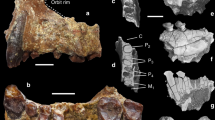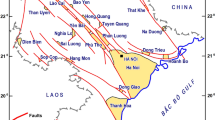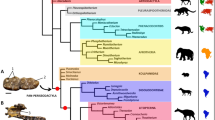Abstract
The important early Miocene site of Buluk, Northern Kenya1, was re-surveyed in 1983. As a result, the faunal list for this site has been expanded and, as we report here, now includes three hominoid and at least one cercopithecoid species. Some of the species were known previously only from North African sites, but others are typically East African. Only Proconsul species have been found before at other East African Miocene sites of equivalent age, but the largest hominoid species from Buluk is an early species of Sivapithecus.
This is a preview of subscription content, access via your institution
Access options
Subscribe to this journal
Receive 51 print issues and online access
$199.00 per year
only $3.90 per issue
Buy this article
- Purchase on Springer Link
- Instant access to full article PDF
Prices may be subject to local taxes which are calculated during checkout
Similar content being viewed by others
References
Harris, J. M. & Watkins, R. Nature 252, 576–577 (1974).
Watkins, R. thesis, Univ. London (1982).
Watkins, R. Proc. geol. Soc. Lond. (in the press).
McDougall, I. & Watkins, R. Nature 318, 175–178 (1985).
Chesters, K. I. M. Palaeontographica 101, 30–71 (1957).
Fleagle, J. Folia Primatol. 24, 1–15 (1975).
Andrews, P. & Walker, A. in Human Origins (eds Isaac, G. LI. & McCown, E. R.) 274–304 (Benjamin, Menlo Park, 1976).
Pilbeam, D., Rose, M. D., Badgley, C. & Lipshutz, B. Postilla 181, 1–94 (1980).
Clark, W. E., LeGros & Leakey, L. S. B. Fossil Mammals of Africa 1, 1–117 (1951).
Pilbeam, D. Bull. Peabody Mus. nat. Hist. 31, 1–185 (1969).
Whybrow, P. J. & Andrews, P. Folia Primatol. 30, 115–125 (1978).
Andrews, P. Bull. Br. Mus. nat. Hist. A30, 85–224 (1978).
Andrews, P. & Tekkaya, I. Palaeontology 23, 85–95 (1980).
De Bonis, L. in New Interpretations of Ape and Human Ancestry (eds Ciochon, R. L. & Corruccini, R. S.) 625–649 (Plenum, New York, 1983).
Greenfield, L. O. in New Interpretations of Ape and Human Ancestry (eds Ciochon, R. L. & Corruccini, R. S.) 695–703 (Plenum, New York, 1983).
Kay, R. F. & Simons, E. L. in New Interpretations of Ape and Human Ancestry (eds Ciochon, R. L. & Corruccini, R. S.) 577–624 (Plenum, New York, 1983).
Simons, E. L. Phil. Trans. R. Soc. B292, 21–41 (1981).
Tauxe, L. Nature 282, 399 (1979).
Pilbeam, D. Nature 295, 232–234 (1982).
Andrews, P. J. & Molleson, T. I. Bull. Br. Mus. nat. Hist. A32, 19–23 (1979).
Simons, E. L., Andrews, P. & Pilbeam, D. R. in Evolution of African Mammals (eds Maglio, V. J. & Cooke, H. B. S.) 120–146 (Harvard University Press, 1978).
Andrews, P. & Cronin, J. E. Nature 297, 541–546 (1982).
Schwartz, J. H. Nature 308, 501–505 (1984).
Author information
Authors and Affiliations
Rights and permissions
About this article
Cite this article
Leakey, R., Walker, A. New higher primates from the early Miocene of Buluk, Kenya. Nature 318, 173–175 (1985). https://doi.org/10.1038/318173a0
Received:
Accepted:
Issue Date:
DOI: https://doi.org/10.1038/318173a0
This article is cited by
-
Cautious climbing and folivory: a model of hominoid differentation
Human Evolution (1995)
-
Evolution and environment in the Hominoidea
Nature (1992)
-
Kenyan finds not early Miocene Sivapithecus
Nature (1986)
-
A new Miocene hominoid from Kenya
Nature (1986)
-
Age of hominoid-bearing sequence at Buluk, northern Kenya
Nature (1985)
Comments
By submitting a comment you agree to abide by our Terms and Community Guidelines. If you find something abusive or that does not comply with our terms or guidelines please flag it as inappropriate.



